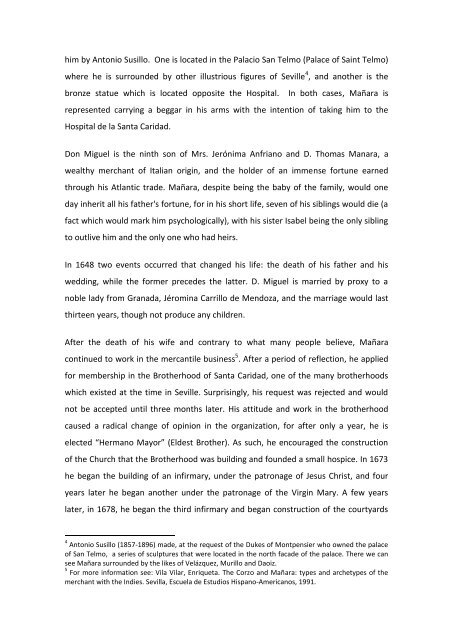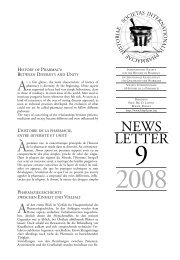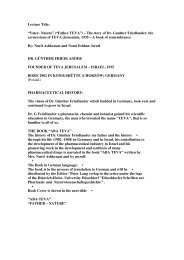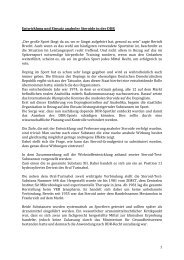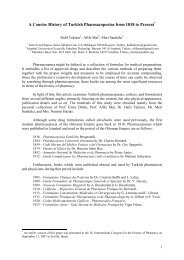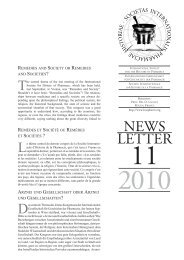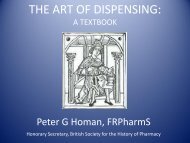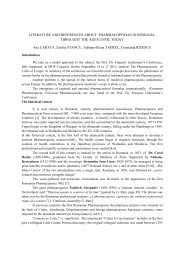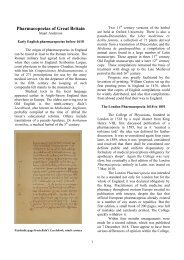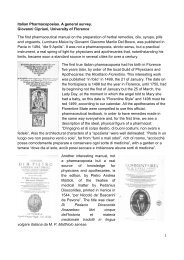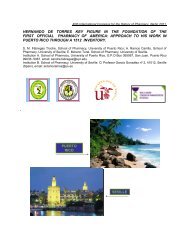don miguel mañara, don juan tenorio and the pharmacy
don miguel mañara, don juan tenorio and the pharmacy
don miguel mañara, don juan tenorio and the pharmacy
Create successful ePaper yourself
Turn your PDF publications into a flip-book with our unique Google optimized e-Paper software.
him by Antonio Susillo. One is located in <strong>the</strong> Palacio San Telmo (Palace of Saint Telmo)<br />
where he is surrounded by o<strong>the</strong>r illustrious figures of Seville 4 , <strong>and</strong> ano<strong>the</strong>r is <strong>the</strong><br />
bronze statue which is located opposite <strong>the</strong> Hospital. In both cases, Mañara is<br />
represented carrying a beggar in his arms with <strong>the</strong> intention of taking him to <strong>the</strong><br />
Hospital de la Santa Caridad.<br />
Don Miguel is <strong>the</strong> ninth son of Mrs. Jerónima Anfriano <strong>and</strong> D. Thomas Manara, a<br />
wealthy merchant of Italian origin, <strong>and</strong> <strong>the</strong> holder of an immense fortune earned<br />
through his Atlantic trade. Mañara, despite being <strong>the</strong> baby of <strong>the</strong> family, would one<br />
day inherit all his fa<strong>the</strong>r's fortune, for in his short life, seven of his siblings would die (a<br />
fact which would mark him psychologically), with his sister Isabel being <strong>the</strong> only sibling<br />
to outlive him <strong>and</strong> <strong>the</strong> only one who had heirs.<br />
In 1648 two events occurred that changed his life: <strong>the</strong> death of his fa<strong>the</strong>r <strong>and</strong> his<br />
wedding, while <strong>the</strong> former precedes <strong>the</strong> latter. D. Miguel is married by proxy to a<br />
noble lady from Granada, Jéromina Carrillo de Mendoza, <strong>and</strong> <strong>the</strong> marriage would last<br />
thirteen years, though not produce any children.<br />
After <strong>the</strong> death of his wife <strong>and</strong> contrary to what many people believe, Mañara<br />
continued to work in <strong>the</strong> mercantile business 5 . After a period of reflection, he applied<br />
for membership in <strong>the</strong> Bro<strong>the</strong>rhood of Santa Caridad, one of <strong>the</strong> many bro<strong>the</strong>rhoods<br />
which existed at <strong>the</strong> time in Seville. Surprisingly, his request was rejected <strong>and</strong> would<br />
not be accepted until three months later. His attitude <strong>and</strong> work in <strong>the</strong> bro<strong>the</strong>rhood<br />
caused a radical change of opinion in <strong>the</strong> organization, for after only a year, he is<br />
elected “Hermano Mayor” (Eldest Bro<strong>the</strong>r). As such, he encouraged <strong>the</strong> construction<br />
of <strong>the</strong> Church that <strong>the</strong> Bro<strong>the</strong>rhood was building <strong>and</strong> founded a small hospice. In 1673<br />
he began <strong>the</strong> building of an infirmary, under <strong>the</strong> patronage of Jesus Christ, <strong>and</strong> four<br />
years later he began ano<strong>the</strong>r under <strong>the</strong> patronage of <strong>the</strong> Virgin Mary. A few years<br />
later, in 1678, he began <strong>the</strong> third infirmary <strong>and</strong> began construction of <strong>the</strong> courtyards<br />
4 Antonio Susillo (1857-1896) made, at <strong>the</strong> request of <strong>the</strong> Dukes of Montpensier who owned <strong>the</strong> palace<br />
of San Telmo, a series of sculptures that were located in <strong>the</strong> north facade of <strong>the</strong> palace. There we can<br />
see Mañara surrounded by <strong>the</strong> likes of Velázquez, Murillo <strong>and</strong> Daoiz.<br />
5 For more information see: Vila Vilar, Enriqueta. The Corzo <strong>and</strong> Mañara: types <strong>and</strong> archetypes of <strong>the</strong><br />
merchant with <strong>the</strong> Indies. Sevilla, Escuela de Estudios Hispano-Americanos, 1991.


